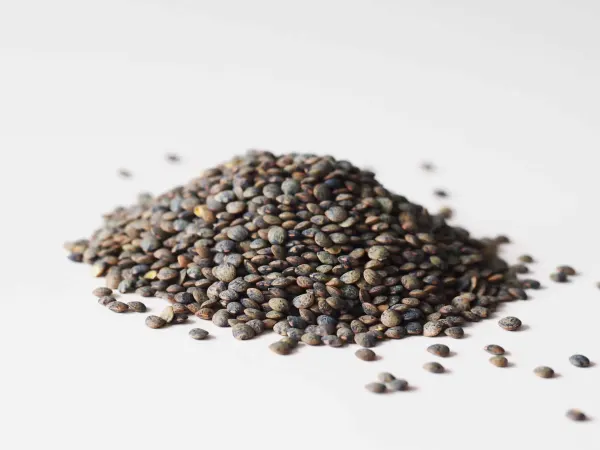Lentil
Legume
Age Suggestion
6 months
Iron-Rich
Yes
Common Allergen
No

When can babies have lentils?
Lentils may be introduced as soon as baby is ready to start solids, which is generally around 6 months of age.
There are many kinds of lentils – each with a distinctive color, flavor, and texture. The tiny legumes originated in the area around the Mediterranean Sea and were introduced to other parts of the globe through colonization and trade. Today, lentils are one of the most widely-used legumes and a staple food in Africa and South Asia, where lentils (called dal) are enjoyed at breakfast, lunch, and dinner.
Are lentils healthy for babies?
Yes. Lentils are rich in B vitamins, including folate to support the nervous system, as well as protein to fuel the muscles and fiber to nourish the gut microbiome. In fact, lentils contain traces of almost every vitamin and mineral that children need as they grow. They are packed with iron and zinc, two essential nutrients that babies often don’t get enough of in their diets. When served with foods that contain lots of vitamin C (like berries, broccoli, cauliflower, citrus, or bell pepper), the body absorbs more of the iron in the lentils.
Are lentils a common allergen?
No. Lentils are not recognized as a common allergen in the United States. However, allergies to lentils are possible. In Spain, lentil allergy impacts a significant portion of the pediatric population.
Being allergic to one type of legume, particularly pea and chickpea (and to a lesser extent, peanut), may increase the risk of allergy to lentils. However, cross-reactivity among legumes is more commonly seen on blood and skin testing than it is in practice. Children with lentil allergy do not necessarily need to avoid all other legumes. Individuals with allergies to birch tree pollen and/or Oral Allergy Syndrome (also called pollen food allergy syndrome) may be sensitive to lentils. Oral Allergy Syndrome typically results in short-lived itching, tingling, or burning in the mouth and is unlikely to result in a dangerous reaction.
As you would when introducing any new food, start by offering a small quantity of lentils for the first few servings. If there is no adverse reaction, gradually increase the amount served over future meals.
Are lentils a choking hazard for babies?
No. Well-cooked lentils present a low risk when safely prepared for a child’s age and developmental ability, though, in theory, an individual could choke on any food. To reduce the risk, prepare and serve lentils in an age-appropriate way. As always, make sure you create a safe eating environment and stay within an arm’s reach of baby during meals.
Learn the signs of choking and gagging and more about choking first aid in our free guides, Infant Rescue and Toddler Rescue.
Videos
Do lentils need to be soaked before cooking?
No, although soaking dried lentils before cooking can help significantly reduce cooking time, as well as reduce the content of lectins and make the food easier to digest.
Here are a couple of soaking methods:
Overnight soak: Use a ratio of 1 lb (454 g) of dried lentils and 10 c (2 ½ liter) water, and soak the lentils in water for 4 or more hours or overnight. Drain and rinse the beans prior to cooking.
Hot soak method: Use a ratio of 1 lb (454 g) of dried lentils and 10 c (2 ½ liter) water, and bring the mixture to a boil for 2-3 minutes. Turn off the heat, then soak for a few hours. Drain and rinse the lentils prior to cooking.
How do you serve lentils to babies?
Every baby develops on their own timeline, and the suggestions on how to cut or prepare particular foods are generalizations for a broad audience.
6 months old +:
Serve soft, scoopable cooked lentil dishes, such as khichdi, masoor dal, or parippu. Alternatively, serve cooked lentils mixed with foods that are easy to scoop, such as mashed vegetables, grain porridges, or yogurt. Encourage self-feeding by letting baby scoop with hands or by pre-loading a utensil for baby to grab. This is also a great age to explore using lentils to make large, soft burgers, patties, and other round foods, whose shapes are easier for babies to pick up and hold.
9 months old +:
Serve soft, scoopable cooked lentil dishes, such as khichdi, masoor dal, or parippu. Alternatively, serve cooked lentils mixed with foods that are easy to scoop, such as mashed vegetables, grain porridges, or yogurt. At this age, you can also serve bite-sized pieces of foods made with lentils, or even clumps of cooked lentils held together with a binding ingredient, but keep in mind that individual lentils may be too small for babies to pick up easily with their developing pincer grasp.
12 months old +:
Offer lentils in meals as desired, from mashed or scoopable dishes to lentil salads and soups. Let the child eat with their hands or offer an age-appropriate utensil for practice. Just remember that small, loose cooked lentils can be tricky to keep on a spoon without some sort of binding ingredient, and using utensils can be exhausting for new eaters, so don’t be surprised if the child toggles back and forth between feeding themselves with their fingers and utensils. Try not to apply too much pressure; consistent and accurate utensil use will come in due time—often sometime after the second birthday.
Our Team
Written by
Expert Tips Delivered to Your Inbox
Sign up for weekly tips, recipes and more!
Copyright © 2024 • Solid Starts Inc





